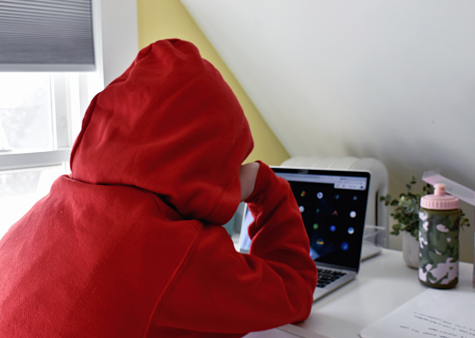Stop the Dress Code Stress

As virtual learning continues, more and more students are choosing to dress down during class. A student listening to a lecture with a hood on, for example, is not an uncommon sight. Due to the unique circumstances of this school year, the previous regulations and standards concerning the dress code should be loosened because everyone has enough to worry about, and the dress code should not be adding to that stress.
With remote learning, students have had trouble focusing in class, especially during Zoom meetings, as learning through a computer screen is much less immersive than being in a physical room with teachers and classmates. If students can wear clothes they feel comfortable in, they may focus better on the material being taught. Zoom meetings can seem distant and unenjoyable, but if students feel more at home, it can be easier to concentrate on the content.
Guidance counselor Mr. Samson Luu says, “Whenever you wear comfortable clothes, it goes back to the idea of ‘when you feel good, you do good.’”
Students are still adjusting to the virtual environment and gaining confidence in their classes, and staring at a computer all day will impact one’s ability to pay attention. As a result, teachers should be focused on making sure the student is absorbing the information.
Mr. Michael Galego, a biology and psychology teacher, further explains that “I don’t prioritize dress code, but rather my students being present and sitting up.” Appearance should not be as important to teachers as engagement is.
Part of the reasoning for enforcing the dress code was that one’s clothing could distract other students. The format of virtual learning, however, means that this issue is no longer present. Zoom’s layout creates an environment in which students are less aware of peers and what they are wearing.
Additionally, features like Screen-Sharing and Speaker View shift the focus away from fellow students and towards the content being presented. A person, therefore, wearing “distracting” clothes at a Zoom meeting often will not take away from the learning of their classmates.
In fact, the limited spots for Zoom screens on one page means that students and their clothing are rarely seen at all. Everything below the camera’s frame, usually from the shoulders down, is not visible to others. This all erases the possibility that their clothing could be distracting.
Furthermore, when a teacher has to reprimand a student to change their outfit, the dress code becomes a disturbance that seeps up valuable class time. The new schedule allows for classes to meet only three times a week, for a total of 145 minutes per subject. Compared to the in-person schedule, this is over an hour less of class time for each class every week.
Not only does virtual learning mandate less class time, but it also requires much more effort from both teachers and students. Teachers have to work harder to engage the students in this new learning environment.
Mr. Salvatore Bartoloma, an eighth grade Latin teacher, describes trying to ease students into the new format as feeling “like I was the cruise director and had to get everyone to socialize with each other, which was tough, [trying] to do that and also teach.”
Zoom has become the new format of learning and adjustments need to be made. Students and teachers are already stressed from trying to adapt to this new structure of learning. Alleviating the pressure of a dress code is long overdue.







